Effective Ways to Create Your Training Plan for Home Workouts in 2025
As we step into 2025, the trend of home workouts continues to dominate the fitness landscape. Developing a Trainingsplan tailored for your personal fitness goals not only ensures you stay engaged but also maximizes your results. With the availability of various resources, you can design a comprehensive plan that includes Fitness, Krafttraining (strength training), and Ausdauertraining (endurance training) all from the comfort of your home. This article will explore how to create an effective workout routine utilizing Bodyweight-Übungen (bodyweight exercises) and available fitness equipment.
We’ll discuss the importance of Trainingsfrequenz (training frequency) and Trainingsintensität (training intensity), and provide insights into creating a balanced Trainingsprogramm that supports your fitness goals. Whether your goal is Muskelaufbau (muscle building) or Fettverbrennung (fat burning), the right plan can lead to significant improvements in your overall fitness.

This article will serve as your roadmap to designing a successful workout routine, complete with practical tips on Stretching, Warm-ups, Cool Down exercises, and tracking your Trainingsfortschritt (training progress). Join us as we explore the essential components of creating a successful home workout strategy for 2025 and beyond!
Essential Components of an Effective Training Plan
Creating a successful home workout plan begins with understanding its essential components. By setting a solid foundation, you can design a program tailored to your individual needs.
Defining Your Fitness Goals
Before launching into a routine, it’s important to clearly define your Fitnessziele (fitness goals). Are you looking to increase your strength, improve your cardiovascular fitness, or lose weight? By pinpointing your objectives, you can create a focused and effective plan. Consider writing down specific goals such as “lose 5 kg in 3 months” or “perform 10 push-ups without stopping.”
Choosing the Right Training Methods
Integrating suitable Trainingsmethoden (training methods) into your program is crucial. Options such as HIIT (High-Intensity Interval Training), Krafttraining, and Yoga each provide unique benefits. For instance, HIIT sessions can effectively enhance your Fettverbrennung without requiring extensive time commitments. Choose methods that align with your preferences and lifestyle.
Incorporating Various Workout Types
In your training plan, it’s advantageous to incorporate a variety of workout styles. This could include Cardio-Workouts for endurance, Krafttraining for muscle building, and Körpergewichtstraining for functional strength. Transitioning between these styles will prevent workout monotony and support overall fitness improvements.
Establishing a Training Schedule
Your training frequency and consistency will greatly influence your results. Aiming for at least 3-4 sessions per week will help you stay committed. Each session should span about 30-60 minutes, ensuring a balance of work and recovery. Utilizing a Trainingstagebuch (training diary) can help you track your adherence to the schedule.
Assessing Your Progress Regularly
To maintain motivation and see tangible results, regularly assess your progress. This could involve taking body measurements, tracking workout performance, or evaluating changes in your fitness level. Adjust your plan as necessary based on these assessments to ensure continuous improvement.
Building on these fundamentals, let’s delve deeper into the specifics of crafting your home workout routines.
Creating Your Home Workout Routine
Now that we understand the essential components, it’s time to focus on how to structure your Workout-Routine. The right combination will not only enhance your motivation but will also optimize your training outcomes.
Designing Full-Body Workouts
A well-rounded routine should incorporate Ganzkörper-Workouts (full-body workouts) that engage multiple muscle groups. This approach maximizes the efficacy of your training sessions by encouraging muscle coordination and balance. For example, a full-body session could include push-ups, squats, lunges, and planks, ensuring each muscle group is activated.
Implementing Intervals for Intensity
Integrating Intervalltraining into your regimen can significantly boost your Trainingseffektivität (training effectiveness). You might alternate between high-intensity exercises such as burpees or sprints and lower-intensity recovery periods. This method enhances both strength and cardiovascular fitness while promoting fat loss.
Incorporating Bodyweight and Equipment Exercises
Maximizing your training at home can involve utilizing your body weight for strength or investing in a few Fitnessgeräte für zuhause (fitness equipment for home). However, if you prefer a minimalistic approach, focus on bodyweight exercises like push-ups, squats, and dynamic planks which can also yield significant strength benefits.
Focusing on Flexibility and Mobility
In addition to strength and cardio, dedicating time to flexibility and mobility is key to preventing injuries. Including a variety of Stretching exercises in your routine, such as yoga poses or basic static stretches, will enhance your overall workout effectiveness and promote recovery.
Establishing a Recovery Strategy
Equally important is your recovery strategy. Incorporate active recovery days and consider techniques like foam rolling or gentle stretching to facilitate muscle recovery. Proper recovery is essential to avoid fitness plateaus and reduce the risk of injury. Wearing a fitness tracker can help gauge your body’s recovery needs.

With your workout routine structured, it’s time to explore the psychological aspect of maintaining motivation in your home workouts.
Staying Motivated in Your Home Training Program
Maintaining motivation during home workouts can be challenging, especially with the convenience of distractions. However, several techniques can boost your motivation and enhance your fitness journey.
Setting Realistic and Achievable Goals
Establishing realistic and measurable goals is fundamental in sustaining motivation. Instead of vague targets, adopt SMART goals—Specific, Measurable, Achievable, Relevant, and Time-bound. For instance, setting a goal to run 5 km in under 30 minutes within the next month provides a clear focus.
Casting a Support Network
Engaging a Trainingspartner (training partner) can also enhance accountability and motivation. Working out with someone else not only provides social interaction but also turns the exercise routine into a more enjoyable experience. Consider joining virtual classes or forming small workout groups online.
Tracking Your Progress for Encouragement
Documentation of your Trainingsfortschritt can serve as a great motivational tool. Regularly checking in on your achievements, no matter how small, will remind you of your progress and encourage you to push further. Fitness apps can greatly assist in monitoring various metrics easily.
Keeping Workouts Engaging and Fun
The most effective home workouts are those that keep you coming back for more. Vary your routines, try new exercises, or even dance around to your favorite music. Incorporating different activities not only avoids boredom but also enhances your overall fitness experience.
Rewarding Yourself
Finally, don’t forget the importance of rewarding your efforts! Whether it’s indulging in a favorite snack after a workout, purchasing new fitness gear, or planning for a relaxing spa day, recognize your hard work and use it as motivation to continue improving.
Safety and Wellness Considerations
When engaging in home workouts, safety and wellness should always take precedence. By adhering to a few critical considerations, you can protect yourself from injuries and train effectively.
Understanding Your Body’s Limits
Being attuned to your body is paramount during exercise. Recognize signs of fatigue, pain, or discomfort. Adjust your workout intensity and type accordingly. Engaging in self-assessment will prevent you from pushing yourself too hard and risking a potential injury.
Proper Warm-Up and Cool Down
Incorporating effective warm-up and cool-down routines is essential. Before each session, perform dynamic stretches to raise your body temperature and prepare muscles for the workout. Post-workout, engage in static stretching to aid recovery and maintain flexibility.
Consult a Professional When Necessary
When unsure about an exercise or if you feel pain, don’t hesitate to consult a fitness professional or a Personal Trainer. They can provide insights, modifications, and guidance for specific training needs or physical challenges.
Nutrition and Hydration
Alongside your training, focusing on a healthy diet and adequate hydration is crucial. A well-balanced Ernährungsplan (nutrition plan) supports your workout goals. Maintain a balance of proteins, fats, and carbohydrates to fuel your body effectively.
Incorporating Recovery Days
Lastly, prioritize rest and recovery as part of your fitness routine. Your body needs time to heal and grow stronger after intense training, so don’t overlook scheduled Trainingspausen (rest days) to maximize long-term results.
Q&A Section: Common Questions About Home Workout Plans
How often should I change my workout routine?
It’s advisable to change your routine every 4-6 weeks to avoid plateaus and keep things fresh. This could involve altering exercises, changing the order, or adjusting your training intensity.
Can I achieve significant muscle gain with bodyweight exercises?
Yes, bodyweight exercises can lead to muscle gain when performed correctly and with challenging variations. Compound movements like push-ups, pull-ups, and squats are effective for building strength.
Is it necessary to use fitness equipment at home?
While equipment can enhance your workouts, it’s not mandatory. Many effective exercises utilize only your body weight, and these can be just as beneficial.
How important is nutrition when following a workout plan?
Nutrition is critical in supporting your workout goals. Proper fueling of your body will enhance performance, recovery, and results. A balanced diet will complement your training efforts.
What’s the best way to stay motivated while working out at home?
Staying motivated can vary for each individual. Setting clear goals, tracking progress, mixing up your routine, and possibly partnering with someone can significantly enhance your motivation.
In summary, creating a successful home workout plan for 2025 involves a well-structured approach, focused on fitness goals and personal preferences. By integrating diverse training methods, remaining mindful of safety, and staying engaged, your journey to achieving your fitness aspirations can be both enjoyable and effective!
